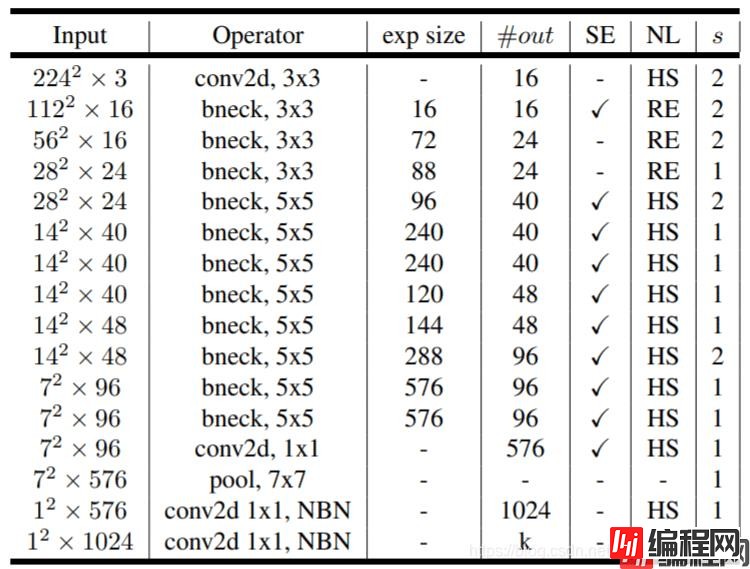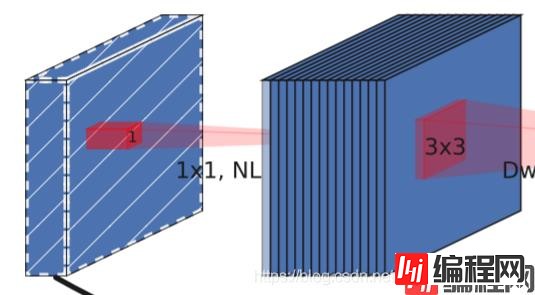Python 官方文档:入门教程 => 点击学习
目录什么是MobileNetV3large与small的区别MobileNetV3(small)的网络结构1、MobileNetV3(small)的整体结构2、MobileNetV3
不知道咋地,就是突然想把small也一起写了。
最新的MobileNetV3的被写在了论文《Searching for MobileNetV3》中。
它是mobilnet的最新版,据说效果还是很好的。
作为一种轻量级网络,它的参数量还是一如既往的小。
它综合了以下四个特点:
1、MobileNetV1的深度可分离卷积(depthwise separable convolutions)。
2、MobileNetV2的具有线性瓶颈的逆残差结构(the inverted residual with linear bottleneck)。
3、轻量级的注意力模型。
4、利用h-swish代替swish函数。
代码下载
其实MobileNetV3中的large与small模型没有特别大的区别,主要的区别是通道数的变化与bneck的次数。

如上为MobileNetV3(small)的表,与MobileNetV3(large)相比,bneck的次数与通道数都有一定的下降。
如何看懂这个表呢?我们从每一列出发:
第一列Input代表mobilenetV3每个特征层的shape变化;
第二列Operator代表每次特征层即将经历的block结构,我们可以看到在MobileNetV3中,特征提取经过了许多的bneck结构;
第三、四列分别代表了bneck内逆残差结构上升后的通道数、输入到bneck时特征层的通道数。
第五列SE代表了是否在这一层引入注意力机制。
第六列NL代表了激活函数的种类,HS代表h-swish,RE代表RELU。
第七列s代表了每一次block结构所用的步长。
bneck结构如下图所示:

它综合了以下四个特点:
a、MobileNetV2的具有线性瓶颈的逆残差结构(the inverted residual with linear bottleneck)。

即先利用1x1卷积进行升维度,再进行下面的操作,并具有残差边。
b、MobileNetV1的深度可分离卷积(depthwise separable convolutions)。

在输入1x1卷积进行升维度后,进行3x3深度可分离卷积。
c、轻量级的注意力模型。

这个注意力机制的作用方式是调整每个通道的权重。
d、利用h-swish代替swish函数。
在结构中使用了h-swishj激活函数,代替swish函数,减少运算量,提高性能。

由于keras代码没有预训练权重,所以只是把网络结构po出来。
from keras.layers import Conv2D, DepthwiseConv2D, Dense, GlobalAveragePooling2D,Input
from keras.layers import Activation, BatchNORMalization, Add, Multiply, Reshape
from keras.models import Model
from keras import backend as K
alpha = 1
def relu6(x):
# relu函数
return K.relu(x, max_value=6.0)
def hard_swish(x):
# 利用relu函数乘上x模拟sigmoid
return x * K.relu(x + 3.0, max_value=6.0) / 6.0
def return_activation(x, nl):
# 用于判断使用哪个激活函数
if nl == 'HS':
x = Activation(hard_swish)(x)
if nl == 'RE':
x = Activation(relu6)(x)
return x
def conv_block(inputs, filters, kernel, strides, nl):
# 一个卷积单元,也就是conv2d + batchnormalization + activation
channel_axis = 1 if K.image_data_format() == 'channels_first' else -1
x = Conv2D(filters, kernel, padding='same', strides=strides)(inputs)
x = BatchNormalization(axis=channel_axis)(x)
return return_activation(x, nl)
def squeeze(inputs):
# 注意力机制单元
input_channels = int(inputs.shape[-1])
x = GlobalAveragePooling2D()(inputs)
x = Dense(int(input_channels/4))(x)
x = Activation(relu6)(x)
x = Dense(input_channels)(x)
x = Activation(hard_swish)(x)
x = Reshape((1, 1, input_channels))(x)
x = Multiply()([inputs, x])
return x
def bottleneck(inputs, filters, kernel, up_dim, stride, sq, nl):
channel_axis = 1 if K.image_data_format() == 'channels_first' else -1
input_shape = K.int_shape(inputs)
tchannel = int(up_dim)
cchannel = int(alpha * filters)
r = stride == 1 and input_shape[3] == filters
# 1x1卷积调整通道数,通道数上升
x = conv_block(inputs, tchannel, (1, 1), (1, 1), nl)
# 进行3x3深度可分离卷积
x = DepthwiseConv2D(kernel, strides=(stride, stride), depth_multiplier=1, padding='same')(x)
x = BatchNormalization(axis=channel_axis)(x)
x = return_activation(x, nl)
# 引入注意力机制
if sq:
x = squeeze(x)
# 下降通道数
x = Conv2D(cchannel, (1, 1), strides=(1, 1), padding='same')(x)
x = BatchNormalization(axis=channel_axis)(x)
if r:
x = Add()([x, inputs])
return x
def MobileNetv3_small(shape = (224,224,3),n_class = 1000):
inputs = Input(shape)
# 224,224,3 -> 112,112,16
x = conv_block(inputs, 16, (3, 3), strides=(2, 2), nl='HS')
# 112,112,16 -> 56,56,16
x = bottleneck(x, 16, (3, 3), up_dim=16, stride=2, sq=True, nl='RE')
# 56,56,16 -> 28,28,24
x = bottleneck(x, 24, (3, 3), up_dim=72, stride=2, sq=False, nl='RE')
x = bottleneck(x, 24, (3, 3), up_dim=88, stride=1, sq=False, nl='RE')
# 28,28,24 -> 14,14,40
x = bottleneck(x, 40, (5, 5), up_dim=96, stride=2, sq=True, nl='HS')
x = bottleneck(x, 40, (5, 5), up_dim=240, stride=1, sq=True, nl='HS')
x = bottleneck(x, 40, (5, 5), up_dim=240, stride=1, sq=True, nl='HS')
# 14,14,40 -> 14,14,48
x = bottleneck(x, 48, (5, 5), up_dim=120, stride=1, sq=True, nl='HS')
x = bottleneck(x, 48, (5, 5), up_dim=144, stride=1, sq=True, nl='HS')
# 14,14,48 -> 7,7,96
x = bottleneck(x, 96, (5, 5), up_dim=288, stride=2, sq=True, nl='HS')
x = bottleneck(x, 96, (5, 5), up_dim=576, stride=1, sq=True, nl='HS')
x = bottleneck(x, 96, (5, 5), up_dim=576, stride=1, sq=True, nl='HS')
x = conv_block(x, 576, (1, 1), strides=(1, 1), nl='HS')
x = GlobalAveragePooling2D()(x)
x = Reshape((1, 1, 576))(x)
x = Conv2D(1024, (1, 1), padding='same')(x)
x = return_activation(x, 'HS')
x = Conv2D(n_class, (1, 1), padding='same', activation='softmax')(x)
x = Reshape((n_class,))(x)
model = Model(inputs, x)
return model
if __name__ == "__main__":
model = MobileNetv3_small()
model.summary()
以上就是python神经网络MobileNetV3 small模型的复现详解的详细内容,更多关于MobileNetV3 small模型复现的资料请关注编程网其它相关文章!
--结束END--
本文标题: python神经网络MobileNetV3 small模型的复现详解
本文链接: https://lsjlt.com/news/117766.html(转载时请注明来源链接)
有问题或投稿请发送至: 邮箱/279061341@qq.com QQ/279061341
2024-03-01
2024-03-01
2024-03-01
2024-02-29
2024-02-29
2024-02-29
2024-02-29
2024-02-29
2024-02-29
2024-02-29
回答
回答
回答
回答
回答
回答
回答
回答
回答
回答
0